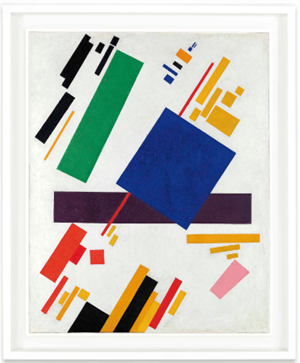
The work will be offered on Christie's Impressionist and Modern Art Evening Sale, New York on 15 May. Estimate On Request.
"When the mind’s habit of seeing depictions of corners of nature, Madonnas and shameless Venuses in paintings vanishes, only then will we see purely painterly works."
Kazimir Malevich, From Cubsim and Futurism to Suprematism, The New Painterly Realism, 1915
On 17th December 1915, the Russo-Polish artist Kazimir Malevich opened an exhibition of his new "Suprematist" paintings in the Dobychina Art Bureau in the recently renamed city of Petrograd. These startling, purely geometric and completely abstract paintings were unlike anything Malevich, or indeed any other modern painter, had ever done before. They were both a shock and a revelation to everyone who saw them. Malevich’s Suprematist pictures were the very first purely geometric abstract paintings in the history of modern art. They comprised solely of simple, colored forms that appeared to float and hover over plain white backgrounds. Nothing but clearly-organized, self asserting painted surfaces of non-objective/non-representational form and color, these pictures were so radically new that they seemed to many people to have announced the end of painting and, even perhaps, of art itself.
Suprematist Composition is one of the finest and most complex of these first, truly revolutionary abstract paintings. Comprised of numerous colored, geometric elements seeming to be dynamically caught in motion, it epitomizes what Malevich defined as his "supreme" or "Suprematist" vision of the world. The painting is not known to have been a part of the exhibition in the Dobychina Art Bureau but is believed to date from this same period of creative breakthrough and, if not included, was, presumably painted very soon after the show closed in January 1916. As had it been painted earlier, it would almost certainly have been included in this first ever showing of Suprematist work, because it is clear, from the frequency with which Malevich later exhibited the picture, that he thought very highly of the painting. Malevich subsequently chose, for example, to include Suprematist Composition in every other major survey of his Suprematist pictures made during his lifetime. These exhibitions ranged from his first major retrospective in Moscow in 1919 to the great travelling retrospective showcasing much of his best work that he brought to the West in 1927. Indeed, it was as a result of this last exhibition, held with great aplomb in Berlin that Suprematist Composition came to form part of the extraordinarily influential group of Malevich’s paintings that remained in the West and which served as almost his sole creative legacy for much of the Twentieth Century. It was at the time of this 1927 exhibition that Malevich had been compelled to return to Russia where he later died in 1935. Hidden in Germany throughout much of the 1930s, Suprematist Composition and the other works from this great Berlin exhibition, were ultimately to become part of the highly influential holdings of Malevich’s work in the Museum of Modern Art in New York and the Stedelijk Museum in Amsterdam. Until 2008, when it was restituted to the heirs of Malevich’s family in agreement with the Stedelijk Museum, Suprematist Composition was on view in Amsterdam as part of the Stedelijk’s unrivalled collection of the artist’s work.
The work will be offered on Christie's Impressionist and Modern Art Evening Sale, New York on 15 May. Estimate On Request.
Kazimir Malevich (1878-1935). Suprematist Composition. Oil on canvas. 34 7/8 x 28 in. (88.7 x 71.1 cm.)
Painted in 1916. Estimate On Request.
Provenance
The artist.
With Hugo Häring, Berlin and Biberach;
Stedelijk Museum, Amsterdam (acquired from the above, circa 1958).
Restituted to the family of the artist (2008); sale, Sotheby's, New York, 3 November 2008, lot 6.
Acquired at the above sale by the present owner.

ArtDependence Magazine is an international magazine covering all spheres of contemporary art, as well as modern and classical art.
ArtDependence features the latest art news, highlighting interviews with today’s most influential artists, galleries, curators, collectors, fair directors and individuals at the axis of the arts.
The magazine also covers series of articles and reviews on critical art events, new publications and other foremost happenings in the art world.
If you would like to submit events or editorial content to ArtDependence Magazine, please feel free to reach the magazine via the contact page.